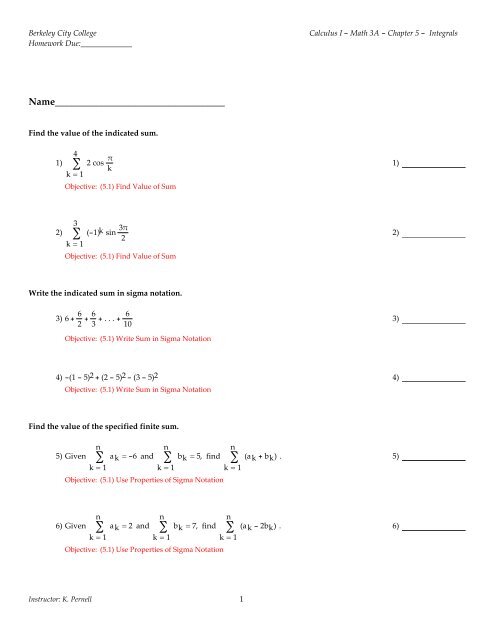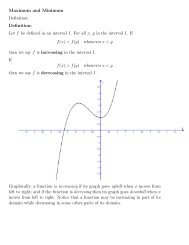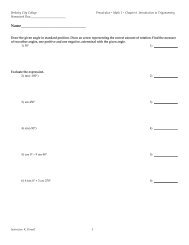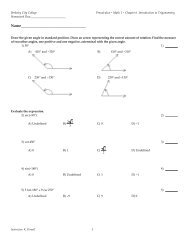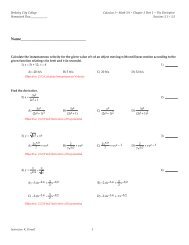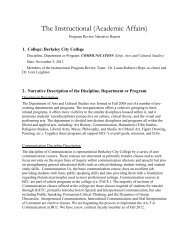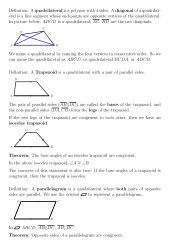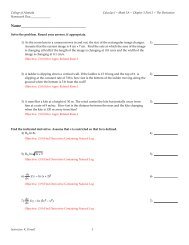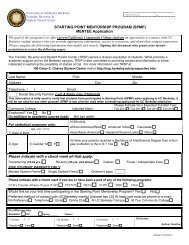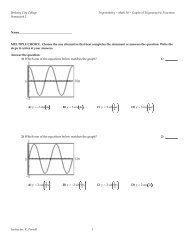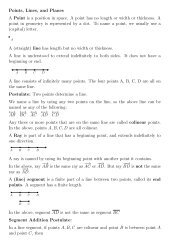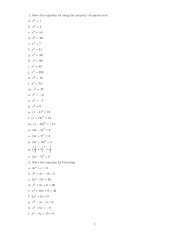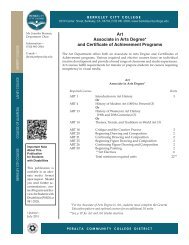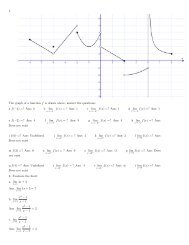Homework 6 â Chapter 5 - Berkeley City College
Homework 6 â Chapter 5 - Berkeley City College
Homework 6 â Chapter 5 - Berkeley City College
You also want an ePaper? Increase the reach of your titles
YUMPU automatically turns print PDFs into web optimized ePapers that Google loves.
<strong>Berkeley</strong> <strong>City</strong> <strong>College</strong><br />
<strong>Homework</strong> Due:_____________<br />
Calculus I - Math 3A - <strong>Chapter</strong> 5 - Integrals<br />
Name___________________________________<br />
Find the value of the indicated sum.<br />
4<br />
1) ∑ 2 cos π 1)<br />
k<br />
k = 1<br />
Objective: (5.1) Find Value of Sum<br />
3<br />
2) ∑ (-1)k sin 3π 2)<br />
2<br />
k = 1<br />
Objective: (5.1) Find Value of Sum<br />
Write the indicated sum in sigma notation.<br />
3) 6 + 6 2 + 6 3 + . . . + 6 10<br />
3)<br />
Objective: (5.1) Write Sum in Sigma Notation<br />
4) -(1 - 5)2 + (2 - 5)2 - (3 - 5)2 4)<br />
Objective: (5.1) Write Sum in Sigma Notation<br />
Find the value of the specified finite sum.<br />
n<br />
n<br />
n<br />
5) Given ∑ ak = -6 and ∑ bk = 5, find ∑ (a k + bk) . 5)<br />
k = 1<br />
k = 1<br />
k = 1<br />
Objective: (5.1) Use Properties of Sigma Notation<br />
n<br />
n<br />
n<br />
6) Given ∑ ak = 2 and ∑ bk = 7, find ∑ (a k - 2bk) . 6)<br />
k = 1<br />
k = 1<br />
k = 1<br />
Objective: (5.1) Use Properties of Sigma Notation<br />
Instructor: K. Pernell 1
Use Special Sum Formulas to find the sum.<br />
7)<br />
24<br />
∑ (8k3 - 12k2)<br />
7)<br />
k = 1<br />
Objective: (5.1) Use Special Sum Formulas to Find Sum<br />
Find the area under the curve of the function on the stated interval. Do so by dividing the interval into n equal<br />
subintervals and finding the area of the corresponding circumscribed polygon.<br />
8) f(x) = 2x2 + x + 3 from x = 0 to x = 6; n = 6 8)<br />
Objective: (5.1) Find Area Under Curve Using Finite Subintervals<br />
Find the formula and limit as requested.<br />
9) For the function f(x) = 6x2 + 1, find a formula for the upper sum obtained by dividing the<br />
interval [0, 3] into n equal subintervals. Then take the limit as n→∞ to calculate the area<br />
under the curve over [0, 3].<br />
Objective: (5.1) Find Area Under Curve as n Approaches Infinity<br />
9)<br />
Calculate the Riemann sum<br />
n<br />
∑ f(xi) △xi for the given data.<br />
i = 1<br />
10) f(x) = x + 4; P: 2 < 2.75 < 3.25 < 4.5 < 5.5; x1 = 2, x2 = 3, x3 = 4.25, x4 = 5 10)<br />
Objective: (5.2) Find Riemann Sum from Given Data<br />
Use the given values of a and b and express the given limit as a definite integral.<br />
n<br />
11) lim ∑ (3 c 2 k<br />
P →0<br />
- 11c k + 3) △xk, a = -5, b = 4 11)<br />
k = 1<br />
Objective: (5.2) Express Limit of Riemann Sum as a Definite Integral<br />
12) lim<br />
P →0<br />
n<br />
∑ c 2 k + 8 △xk, a = -7, b = 2 12)<br />
k = 1<br />
Objective: (5.2) Express Limit of Riemann Sum as a Definite Integral<br />
2
Evaluate the definite integral using the definition.<br />
13)<br />
5<br />
∫ 3 dx<br />
13)<br />
-3<br />
Objective: (5.2) Evaluate Definite Integral Using Definition<br />
14)<br />
4<br />
∫ (-2x + 8) dx<br />
14)<br />
-8<br />
Objective: (5.2) Evaluate Definite Integral Using Definition<br />
Solve the problem.<br />
15) The velocity of an object is given by the velocity function v(t) = t/42. If the object is at the<br />
origin at time t = 0, find the position at time t = 20.<br />
Objective: (5.2) Find Position Given Velocity Function<br />
15)<br />
16) An objectʹs velocity function is graphed below. Determine the objectʹs position at time<br />
t = 40 assuming the object is at the origin at time t = 0.<br />
16)<br />
6<br />
v<br />
5<br />
4<br />
3<br />
2<br />
1<br />
20 40 60 80 100 120<br />
t<br />
Objective: (5.2) Find Position Given Graph of Velocity Function<br />
17) Suppose that f and g are continuous and that<br />
11<br />
Find ∫ 4f(x) + g(x) dx .<br />
7<br />
Objective: (5.3) Evaluate Definite Integral Using Properties<br />
∫<br />
7<br />
11<br />
f(x) dx = -4 and<br />
11<br />
∫ g(x) dx= 9.<br />
7<br />
17)<br />
3
Find Gʹ(x).<br />
18) G(x) =<br />
x4<br />
∫ sin t dt<br />
18)<br />
0<br />
Objective: (5.3) Differentiate Integral<br />
19) G(x) = ∫<br />
x<br />
18t7 dt<br />
19)<br />
1<br />
Objective: (5.3) Differentiate Integral<br />
x<br />
20) G(x) = ∫ 4x + 3 dt<br />
20)<br />
0<br />
Objective: (5.3) Differentiate Integral<br />
x4<br />
21) G(x) = ∫ cos t dt<br />
21)<br />
0<br />
Objective: (5.3) Differentiate Integral<br />
22) f(x) =<br />
x<br />
1<br />
∫<br />
u2 du<br />
22)<br />
0<br />
Objective: (5.3) Find Intervals of Monotonicity/Concavity<br />
4
Answer the question.<br />
23) Consider the function G(x) =<br />
x-region [0, 12].<br />
The graph is given below:<br />
∫<br />
0<br />
x<br />
f(t) dt , where f(t) oscillates about the line y = 2 over the<br />
23)<br />
15<br />
y<br />
10<br />
5<br />
-5<br />
1 2 3 4 5 6 7 8 9 10 11 12<br />
t<br />
-10<br />
-15<br />
At what values of x over this region do the local maxima of G(x) occur<br />
Objective: (5.3) Analyze Graph of Function<br />
Evaluate the integral.<br />
1<br />
24) ∫<br />
8<br />
t2 dt<br />
24)<br />
0<br />
Objective: (5.4) Evaluate Definite Integral<br />
25)<br />
4<br />
∫ 2 x dx 25)<br />
0<br />
Objective: (5.4) Evaluate Definite Integral<br />
26)<br />
3π/2<br />
∫ 14 cos x dx<br />
26)<br />
π/2<br />
Objective: (5.4) Evaluate Definite Integral<br />
5
27) ∫ x7(x8 - 10) 4 dx 27)<br />
Objective: (5.4) Find Integral Using Substitution<br />
28) ∫ 10x2<br />
4<br />
3 + 4x 3 dx 28)<br />
Objective: (5.4) Find Integral Using Substitution<br />
29) ∫ x2 cos (x3 + 6) sin (x3+ 6) dx<br />
29)<br />
Objective: (5.4) Find Integral Using Substitution<br />
Evaluate the definite integral.<br />
30)<br />
2<br />
∫ (x + 2)3 dx<br />
30)<br />
0<br />
Objective: (5.4) Evaluate Definite Integral Using Substitution<br />
31)<br />
6<br />
5<br />
∫ dx 31)<br />
(6 + x)2<br />
0<br />
Objective: (5.4) Evaluate Definite Integral Using Substitution<br />
32)<br />
1<br />
6 x dx<br />
∫<br />
0 16 + 3x2<br />
32)<br />
Objective: (5.4) Evaluate Definite Integral Using Substitution<br />
33)<br />
2π<br />
∫ 3 cos2x sin x dx<br />
33)<br />
π/3<br />
Objective: (5.4) Evaluate Definite Integral Using Substitution<br />
34)<br />
π<br />
∫ (1 + cos 7t)2 sin 7t dt<br />
34)<br />
0<br />
Objective: (5.4) Evaluate Definite Integral Using Substitution<br />
6
Solve the problem.<br />
35) A certain company has found that its expenditure rate per day (in hundreds of dollars) on<br />
a certain type of job is given by Eʹ(x) = 6x + 9, where x is the number of days since the start<br />
of the job. Find the expenditure if the job takes 8 days.<br />
Objective: (5.4) Solve Apps: Fundamental Theorem of Calculus<br />
35)<br />
36) A certain object moves in such a way that its velocity (in m/s) after time t (in s) is given by<br />
V(t) = t2 + 2t + 8. Find the distance traveled during the first four seconds.<br />
Objective: (5.4) Solve Apps: Fundamental Theorem of Calculus<br />
36)<br />
Use symmetry to help evaluate the integral.<br />
37)<br />
π/3<br />
∫ (cos x + sin x) dx<br />
37)<br />
-π/3<br />
Objective: (5.5) Evaluate Integral Using Symmetry<br />
38)<br />
1<br />
∫ (2 + 4x + 3x2 + x3) dx<br />
38)<br />
-1<br />
Objective: (5.5) Evaluate Integral Using Symmetry<br />
Use the requested method to approximate the definite integral.<br />
39) Use the method of left Riemann sum with n = 4 to approximate the value of<br />
Objective: (5.6) Use Riemann Sum to Approximate Integral<br />
7<br />
∫ x2 dx 39)<br />
3<br />
40) Use the method of right Riemann sum with n = 4 to approximate the value of<br />
Objective: (5.6) Use Riemann Sum to Approximate Integral<br />
5<br />
∫ x2 dx 40)<br />
1<br />
41) Use the method of midpoint Riemann sum with n = 4 to approximate the value of<br />
5<br />
x2 dx<br />
∫<br />
1<br />
Objective: (5.6) Use Riemann Sum to Approximate Integral<br />
41)<br />
7
Express the limit as a definite integral where P is a partition of the given interval.<br />
42) lim P →0<br />
n<br />
∑ (3 c 2 k - 9c k + 9) △xk, [-10, 4] 42)<br />
k = 1<br />
Objective: (5.3) Express Limit of Riemann Sums as Definite Integral<br />
43) lim P →0<br />
n<br />
∑ c 5 k △xk, [-5, 4] 43)<br />
k = 1<br />
Objective: (5.3) Express Limit of Riemann Sums as Definite Integral<br />
8
Answer Key<br />
Testname: 13FALL_CH5_PROBS<br />
1) 2 cos π + 2 cos π 2 + 2 cos π 3 + 2 cos π 4 = -1 + 2<br />
2) -sin 3π 2 + sin 3π 2 - sin 3π 2 = 1<br />
10<br />
1<br />
3) 6 ∑<br />
i<br />
i = 1<br />
3<br />
4) ∑ (-1)k (k - 5)2<br />
k = 1<br />
5) -1<br />
6) -12<br />
7) 661,200<br />
8) 221<br />
9) 3 + 324n 3 + 486n2 + 162n<br />
; Area = 57<br />
6n3<br />
10) 27.3125<br />
4<br />
11) ∫ (3x2 - 11x + 3) dx<br />
-5<br />
2<br />
12) ∫ x2 + 8 dx<br />
-7<br />
13) 24<br />
14) 144<br />
15) 100<br />
21<br />
16) 160<br />
17) -7<br />
18) 4x3 sin (x4)<br />
19) 9x3<br />
20) 4x + 3<br />
21) 4x3 cos (x2)<br />
22) f(x) is increasing on (-∞, 0) and (0, ∞)<br />
f(x) is concave up on (-∞, 0)<br />
23) ≈ 2.1, ≈8.0<br />
1<br />
24)<br />
1536<br />
25) 32<br />
3<br />
26) -28<br />
27) (x 8 - 10) 5<br />
+ C<br />
40<br />
29) 2 9 (sin (x 3 + 6)) 3/2 + C<br />
30) 60<br />
5<br />
31)<br />
12<br />
32) 2 19 - 8<br />
33) - 7 8<br />
8<br />
34)<br />
21<br />
35) $26,400<br />
36) 69.3 m<br />
37) 3<br />
38) 6<br />
39) 86<br />
40) 54<br />
41) 41<br />
42)<br />
4<br />
∫<br />
-10<br />
(3x2 - 9x + 9)<br />
43)<br />
4<br />
∫ x5 dx<br />
-5<br />
dx<br />
28) 2 3 (3 + 4x 3) 5/4 + C<br />
9


